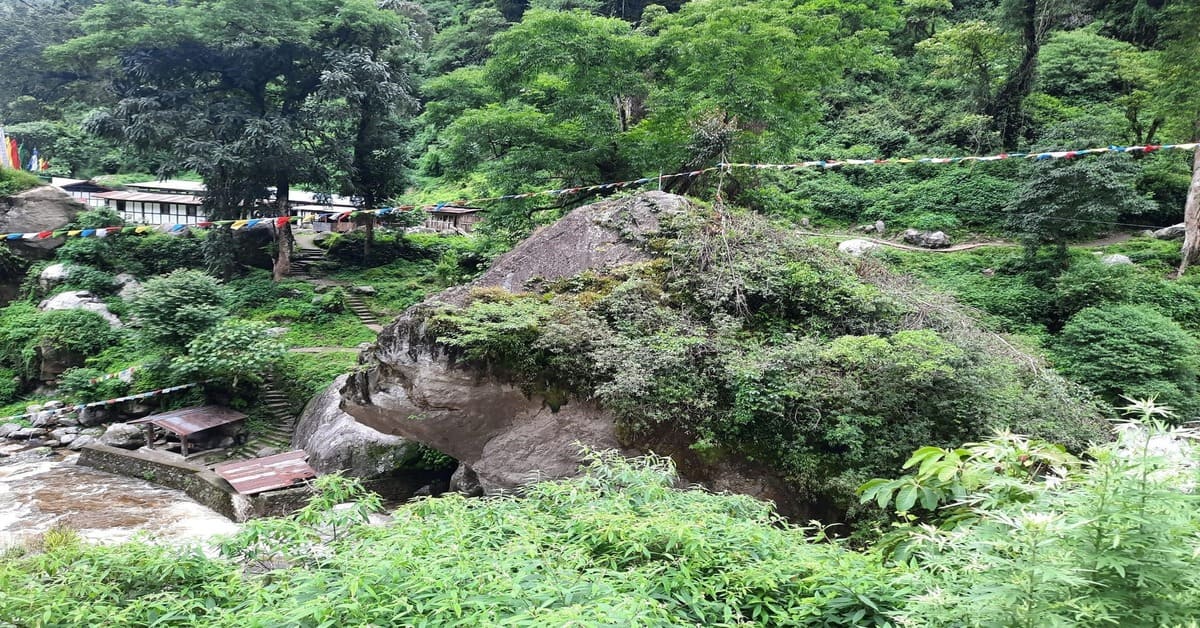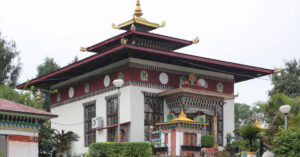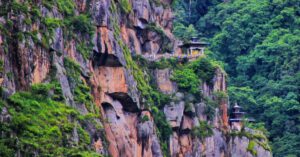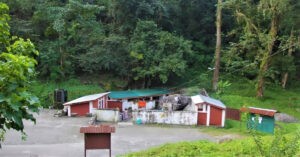Koma Tshachu is one of the oldest and most culturally significant hot springs in Bhutan, believed to have been blessed by Guru Rinpoche in the 8th century. It is located within the Jigme Dorji National Park, under Goenshari Gewog of Punakha Dzongkhag at 1839 meters.
The visitors come to experience the healing benefits of the hot springs, which are said to alleviate various ailments. Koma Tshachu is also famous for healing broken bones and joints.
Although the temperature of the hot spring has decreased over the decades, people’s faith in its healing effects has remained. The most popular hot springs in Bhutan are the Chubu and Koma hot springs in Punakha; the Duenmang hot spring in Zhemgang; the Khempajong Nye hot spring in Lhuntse; the Gasa hot spring in Gasa; and the Gelephu hot spring in Sarpang.
How to Reach Koma Tshachu in Punakha
To reach Koma Tshachu, drive along the Punakha-Gasa Highway from Khuruthang town via Tshorim Zam for around one hour and thirty minutes until the turning junction called Tshorim Zam leading to Goenshari village.
Koma Tshachu Hike: Tshorim Zam is the beginning point of two short treks – Koma Tshachu and Guru Rinpoche caves. After crossing the bridge, hike uphill through warm broadleaf forests for about two and a half hours. After an hour’s hike, the slope gets gentler and runs alongside a rumbling river beside the Koma Tshachu.
Also Read: How to Reach Gasa Hot Spring
The Trek Route of Koma Tsachu
- Start from Punakha Khuruthang town;
- Khuruthang town to Gon Shari village junction: 1 hour and 30 minutes to drive;
- Tshori Zam to Koma Tshachu: 2-hour trek.
Also Read: How to Trek to Dur Hot Spring in Bumthang
The Origin of Koma Tshachu
There is no written history of Koma Tshachu about its origin. However, the hot spring is considered sacred as it is believed to have been blessed by Guru Rinpoche in the 8th century. This is evident with the presence of the sacred sites (Cave) of Guru Rinpoche in the Tshachu vicinity.
Also Read: The Origin of Chubu Tshachu in Punakha
Description of Koma Tsachu
The hot spring is situated at the base of the hill of Ney Rinchen Dzong. Given that it is located on the way to Goen Tshephu Ney, it is considered the seat of Guru Rinpoche.
Also Read: The Sacred Sites of Guru Rinpoche in Bhutan
A new 50-meter suspension bridge was officially opened to the public in 2024 to improve visitor accessibility to Koma Tsachu and support the local economy of Goenshari Gewog.
The Goenshari Gewog administration manages the hot spring site. The income generated from the hot spring is reinvested into the construction and maintenance of essential amenities to ensure the site’s sustainability and enhance the visitor experience.
Koma Tshachu has three pools covered with corrugated galvanized roofing sheets. The first pool on the other side of the stream is situated at an altitude of 1860 meters. The second pool is on the side of the stream at an altitude of 1850 meters. The third pool, a Medicinal Water (Menchu), is also on the other side of the stream at 2600 meters above sea level.
Also Read: Menchu or Medicinal Springs in Bhutan: Beliefs and Benefits
Therapeutic Values or Ethnopharmacological Benefits of Koma Tshachu
The first pool, with a temperature of 38.3°C, is a warm hot spring and has healing properties for wind disorders, bile disorders, dizziness, defective bile, complicated convulsions, headache, and low vision.
The second pool, a Medicinal Spring Water (Menchu) with a temperature of 33.20°C, is a tepid hot spring with curative properties for skin diseases, indigestion, stiff muscles, festering wounds, fractures, serous fluids, increasing mucus because of suppressed wind, swellings, inflicted by evil spirits, and combined disease of defective wind and bile. This is the pool where the 69th Je Khenpo Geshey Gendün Rinchen used to bathe. Although the temperature of this pool is very low, people bathe in this pool as Je Geshey Gendun Rinchen personally blessed the pool.
The third pool with a temperature of 38.3°C is a warm hot spring good for joint pain, chronic tumors, and anal fistula. However, people with high blood pressure are advised not to bathe for long in the Tshachu.
Also Read: Therapeutic Values or Ethnopharmacological Benefits of Duenmang Tshachu
Accommodation at Koma Tshachu
There is a four-roomed accommodation. The room is very simple with solar electricity and is taken care of by a few young boys who also provide meals. Facilities are relatively minimal because of the hot spring’s isolation and tiny size. Visitors are recommended to reserve accommodation in advance. Although a few small stores have sprouted around the hot spring, the only true alternative, if all of the accommodations are full, is to camp and bring your tent. There is much space around the site to pitch tents, as well as overhanging rocks to camp under. Porters and ponies can be hired by consulting the local leader of the Tshori Zam community.
Contact the caretaker, Mrs. Kinley Wangmo, at 17568173 or 17334773 for booking the guesthouse and for further information.
Also Read: Accommodation at Gelephu Tshachu
Best Time to Visit Koma Tshachu
The best time to visit Koma Tshachu is between September and January. It is considered auspicious to visit Tshachu from the eighth month until the twelfth month of the Bhutanese calendar. It is believed that one should dip for at least three continuous days to get the full effect of the minerals of Tshachu. Don’t miss trekking to the Guru Rinpoche caves nearby. You can visit major hot springs in Bhutan with the Bhutan Pilgrimage Package.
Enjoyed reading this blog?




